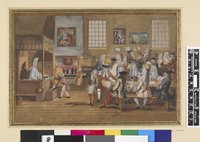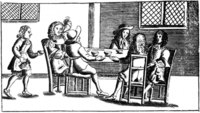Visual Coffee-house sources from the late 17th and early 18th century in England
This image is an advertisement for Manwarings Coffee House with an estimated date of 1700. The image shows a group of four men sitting at the Manwaring Coffee House. Below the image reads the caption “Will’s Best Coffee Powder at Manwarings Coffee House in Falcon Court over against St. Dunstans Church in Fleet Street”. Each of the four men appear to be well dressed, two of them wearing peruke’s, a symbol for wealth at the time. The other two men The men are wearing broad brimmed hats a symbol for a Royalist cavalier (Ellis, 81). A fifth man on the far left is wearing a apron around his waist and is pouring up a cup of coffee to be served. The men seem to be engaged in conversation while they read pamphlets and the newspaper. Two of them have pipes, one with his set down on the table, the other with his near his mouth. The well dressed image of each of the four men lines up perfectly with Samuel Pepys account of his experience, he made the decision to spend less money at the alehouse’s and more on clothes and his appearance (The Coffee House, 57).
This drawing, acquired by The British Museum in 1931, and created between the years 1690 and 1700, depicts the interior of a coffee house during the same era, with museum curator’s estimation being in the mid to late 1690’s. The artist of the image is Anonymous. The drawing shows several groups of men seated and standing around different tables, in the midst of conversation. Many of the men are holding newspapers and cups of coffee, and two can be seen inspecting a painting on the wall with a candle. There is a woman tending the bar and a large cauldron of coffee over a fire in the corner. There is clearly a lot going on in this image, and you get the impression that it would be quite noisy inside this Coffee-house.
This image is thought to be the oldest image depicting the inside of a Coffee-house. It is a black and white wood cut dated to 1674, meaning this is showing a Coffee-house from the period of Charles II’s reign. There are five men seated around a large table. There are several coffee cups on the table, and an employee of the Coffee-house is shown on the left of the image, ready to set down another cup for a customer. One of the customers at the table is smoking a pipe, and another has his placed on the table.
As Markman Ellis, Professor of 18th century studies at Queen Mary University of London writes, the Coffee-house was a business that sold both coffee and newspapers (Ellis, xi). In each of these images, it is clear that newspapers were just as prevalent in Coffee-houses as cups of coffee were. Steven Pincus, Professor of British History at the University of Chicago, builds on this point in his journal article “Coffee Politicians Does Create”: Coffeehouses and Restoration Political Culture. He quotes a pamphlet titledCoffee-Houses Vindicated dated to 1675, “[in a coffeehouse] for a penny or two you may spend 2 or 3 hours, have the shelter of a house, the warmth of a fire, the diversion of company and conveniency if you please of taking a pipe of tobacco” (Pincus, 817). This builds on the themes we are able to see in these visual representations of the coffee-houses. It doesn’t appear that every man actually has a cup of coffee in front of him, several are just seated at the table and a few have pipes with them. Overall, these images lead the viewer to believe that these establishments were very comfortable spaces. In two of the images we can see a fire place. The customers in each image all look to be occupied and entertained. From an outsiders perspective, simply looking at these images, there is no reason at all to believe that these houses would be viewed in a negative light by citizens, it does not seem messy, violent, or over crowded, but civil and clean. However, anti Coffee-house satire was popular during this time period, dozens of them reprinted in Markman Ellis’ Eighteenth-Century Coffee-House Culture, volume 1.



